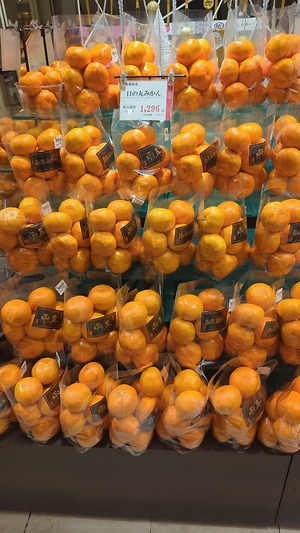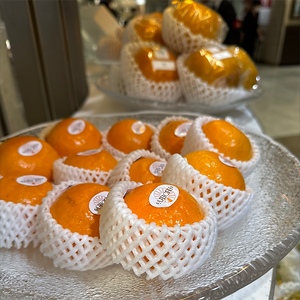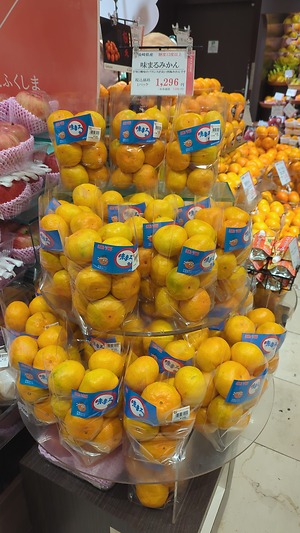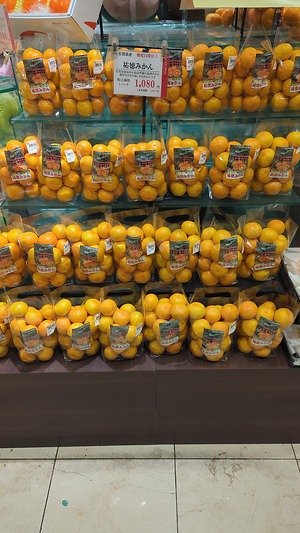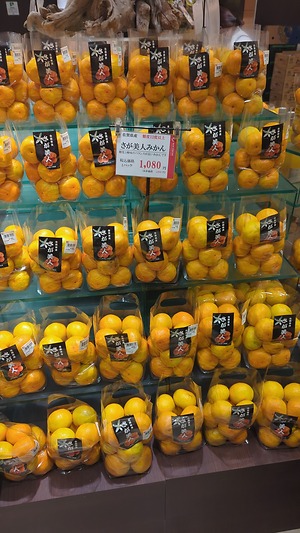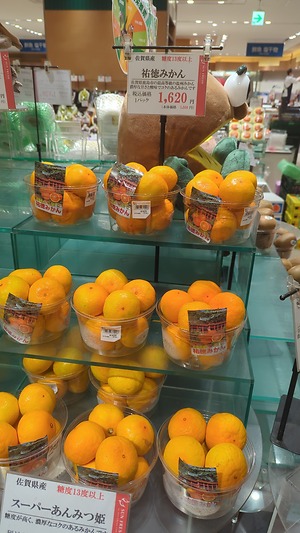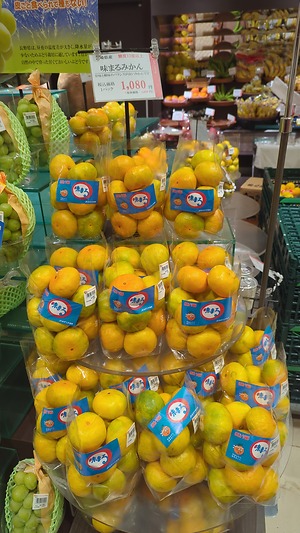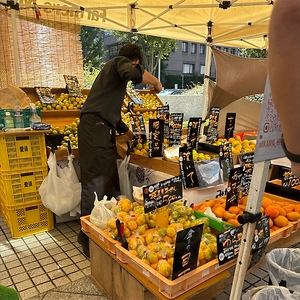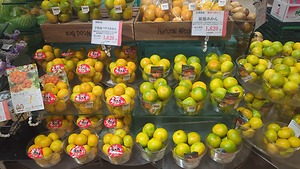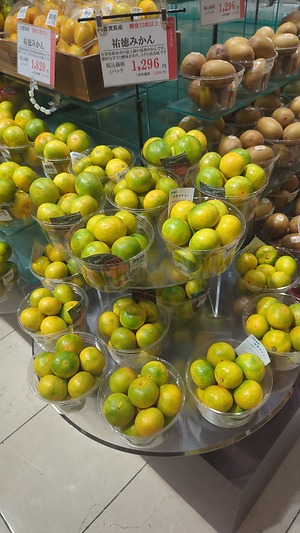


Japanese Mikan Oranges
Estimated Inventory, lb : 0
Description/Taste
Mikan oranges are a small to medium-sized varietal, averaging 6 to 8 centimeters in diameter, and have a round to oblate shape with a flattened top and bottom and a broad, curved middle. The fruit's rind is thin and easy to peel, having a delicate nature prone to bruising and tears. The rind also showcases an orange to orange-red coloring and has a leathery, smooth, and taut appearance, covered in prominent oil glands giving the surface a pebbled texture. Underneath the rind, there is a thin, almost nonexistent layer of the white pith, enveloping flesh that is divided into 10 to 12 segments by thin membranes with a hollow center. The orange flesh is firm but tender with an aqueous, succulent, and almost melting consistency and is either seedless or contains a few ivory seeds. Mikan oranges are aromatic and have a mild, sweet, and subtly tangy taste. It is important to note that each Mikan variety will vary in sugar and acidity, creating a range of flavors from sweet, sweet and tangy, to sweet-tart. Some growers will also store the fruits to reduce the acid content and enhance the sweetness.
Seasons/Availability
Mikan oranges are available in the late fall through spring.
Current Facts
Mikan oranges, botanically classified as Citrus unshiu, are a type of Asian citrus belonging to the Rutaceae family. The word Mikan essentially translates to "mandarin," a general descriptor used for many different varieties grown worldwide. In Japan, the name Mikan most closely refers to a type of mandarin known as Unshu mandarin, Honey Citrus, or Japanese mandarin. Mikan oranges are favored for their cold hardiness and low heat requirements, allowing the fruits to be grown in climates where other citrus varieties may not be able to thrive. Mikans also have an extended growing season, appearing late fall through early spring. In Japan, Mikans are further divided into four categories according to their ripening times. Goku wase are super early fruits, harvested from September through October, while wase are early season fruits, appearing in October through December. These early-season fruits are generally tarter and have more acidity. Nakate fruits are harvested from November through December, and Okute or Futsu Unshu is the main season for the fruits, arriving in markets from January through March. The late-season Mikans have a sweeter, milder taste. Mikan oranges are commercially produced worldwide and are celebrated for their primarily sweet, subtly tangy flavor, typically consumed in fresh preparations.
Nutritional Value
Mikan oranges are a source of fiber to regulate the digestive tract, vitamin A to maintain healthy organ functioning, and potassium to balance fluid levels within the body. The oranges also provide vitamin C to strengthen the immune system while reducing inflammation, calcium to build strong bones and teeth, folate to develop RNA and DNA, magnesium to control optimal nerve functioning, and other nutrients, including vitamin E, iron, and copper. In Japan, dried Mikan rinds are used in bathwater as a natural way to nourish the skin. They are also used as household cleaners, rubbed on surfaces to remove dirt and grime.
Applications
Mikan oranges have a sweet, subtly tangy taste suited for fresh preparations. The oranges are typically consumed straight out of hand and are valued for their easy-to-peel nature and juicy, sweet flavor. The flesh can be segmented and layered into parfaits, added to whipped cream fruit sandwiches, or placed as a fresh garnish for desserts. Mikan oranges can also be dipped in chocolate, chopped into salsas and dips, or sliced and layered on bruschetta. In addition to using the segments, the juice can be frozen into sorbet, used as a filling for mochi, or mixed into gelatin and pudding. Try infusing Mikan juice into cocktails, smoothies, dressings, or marinades as a fresh addition. Mikan oranges can also be simmered into jams, jellies, and glazes for roasted meats. In Japan, Mikan peels are dried and used in various applications, known as chimpi. The rinds are customarily dried in the sun for a few weeks, and once ready, they are ground into a powder and used as a seasoning. Chimpi can also be incorporated into hot water as a beverage, mixed with honey, for a sweeter taste. Mikan oranges pair well with spices such as cinnamon, ginger, cardamom, allspice, and cloves, herbs including cilantro, mint, parsley, and chives, maple syrup, honey, chocolate, and vanilla. Whole, unpeeled Mikan oranges will keep for a few days at room temperature and 1 to 2 weeks when stored in the refrigerator.
Ethnic/Cultural Info
In the district of Maana in the Ehime Prefecture of Japan, Mikans are a life-giving crop. Mikan oranges account for approximately seventy percent of the citrus grown and sold within the Ehime Prefecture. The Mikan was introduced to the Maana district several hundred years ago and was commercially planted in 1891. The citrus was sown along the steep, rocky hillsides in terraced fields facing the Uwa Sea. The tiered fields created an environment suitable for Mikan production with ample sunshine, a warm climate, low rainfall, well-drained soil, and a mineral-rich, salty breeze. Local growers say Maana Mikans are sown on the land with three suns: sunshine from the actual sun, light from the reflection of the ocean, and sunlight off the rock walls protecting the terraced fields. Maana Mikans have fragile, delicate skins and melting, juicy flesh, primarily eaten fresh as a delicacy. Approximately 180 households grow Mikans throughout Maana, and over 7,000 to 8,000 tons are harvested annually and shipped to other regions of Japan. Maana Mikans were once so valuable that they were used as a form of currency, paying for local bar tabs and other outstanding bills. Maana Mikans were also the first citrus to be awarded the Emperor's Cup, the highest agricultural award in Japan. In the modern day, the region is registered as a Japanese Nationally Important Agricultural Heritage Systems site by the Minister of Agriculture, Forestry, and Fisheries, and harvest season attracts workers domestically and internationally. Maana Mikans are traditionally picked by hand, first, hand-cut from the branch and then cut from the stem, leaving as little as possible for more accessible transport. Beyond the mandarin's use as a cash crop, Mikans are believed to have anti-aging properties. In December, O-Mikan-Yaki is an annual practice of roasting Mikans. The tradition includes ceremonial offerings at shrines, and then the mandarins are skewered onto wooden sticks and placed into a fire. The wooden skewers burn, essentially steaming the fruits from the inside. Eating a roasted Mikan is believed to bring protection from sickness in the year to come.
Geography/History
The origins of Mikan oranges are disputed, as some experts trace the citrus to Japan while others point to China as its origination site. Regardless of their exact origins, Mikan oranges have been growing in the city of Wenzhou in the Zhejiang Province of China since ancient times. The oranges were carried from Wenzhou to Japan, and the name Unshu is believed to be a corruption of the name Wenzhou. Mikans are thought to be a cross between a Kishu and a Kunenbo, a discovery that was made through DNA testing performed by the National Agricultural and Food Research Organization, or NARO, in 2016. Mikans were first recorded in Japan sometime around the 14th century, and by the late 18th century, they were being cultivated in Ehime and other prefectures across the country. Mikans were also sent to Europe and the United States, where they were planted in Florida in 1878. Trees of the variety were sent to the American Minister of Japan, General Van Valkenberg, in Florida. Legend has it that the boxes were labeled with Satsuma, a moniker that described where the fruits came from in Japan, and this name officially became a name for the variety in the United States in the 1880s. Today Mikans are grown worldwide and are sold fresh or canned in Asia, Europe, Australia, South America, and the United States. In Japan, the Wakayama, Ehime, and Shizuoka Prefectures are the top production regions. When in season, Mikan oranges are sold through farmer's markets, specialty grocers, and distributors.
Recipe Ideas
Recipes that include Japanese Mikan Oranges. One
| Serena Bakes Simply From Scratch |
|
Beet Orange Salad |



